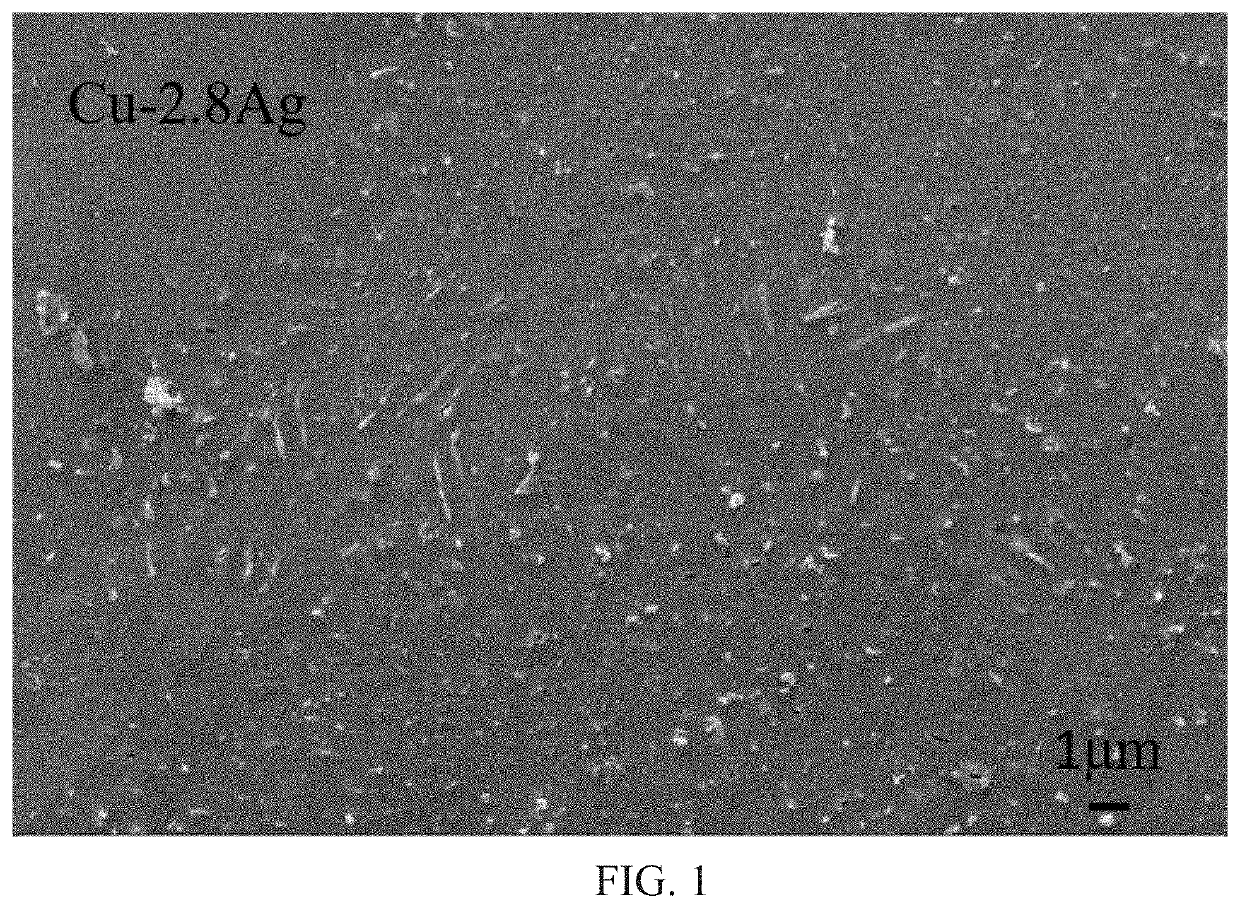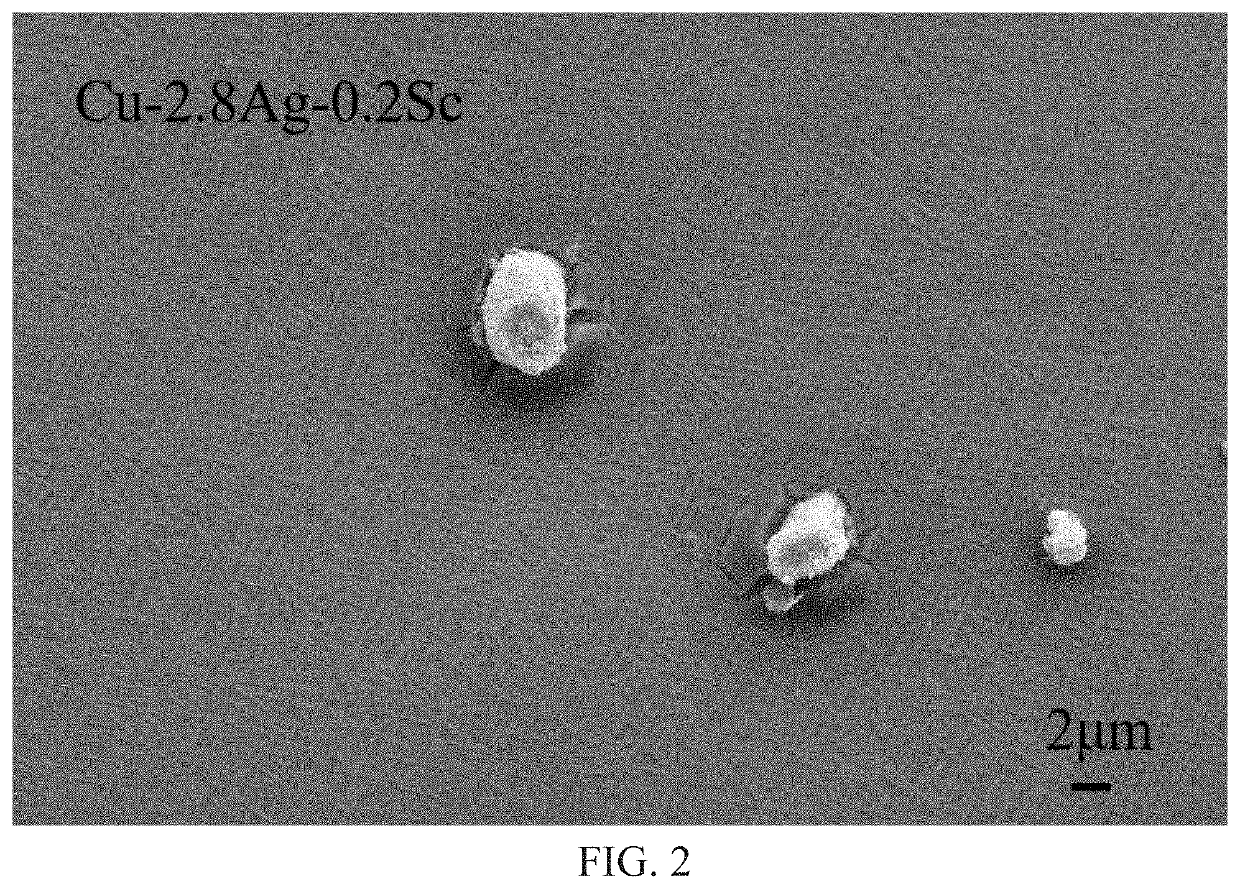High-strength and high-conductivity cu-ag-sc alloy and preparation method thereof
a high-conductivity, cu-ag-sc technology, applied in the field of nonferrous metal alloys, can solve the problems of limited application, high cost of ag, and insufficient strength to meet the requirements of modern industries, and achieve the effects of improving the strength of the alloy, ensuring solid solubility, and remarkably high strength of the cu-ag-sc alloy
- Summary
- Abstract
- Description
- Claims
- Application Information
AI Technical Summary
Benefits of technology
Problems solved by technology
Method used
Image
Examples
embodiment 1
[0024]Metal Ag and metal Sc were placed in an electric-arc furnace and smelted under a vacuum condition, in which the vacuum degree is smaller than or equal to 10−2 MPa, then, cooled to normal temperature in the furnace to obtain an Ag—Sc intermediate alloy, wherein the Ag—Sc intermediate alloy includes 5 wt % Sc.
[0025]The Ag—Sc intermediate alloy, an electrolytic copper and the metal Ag were placed in an induction furnace, heated to 1300° C. under a vacuum condition, in which the vacuum degree is smaller than or equal to 10−2 MPa, kept at the temperature for 15 min for smelting, then, casted and cooled to normal temperature in the furnace to obtain ingots. The components of the ingots are: 1 wt % Ag, 0.1 wt % Sc and the balance Cu;
[0026]The ingots were heated to 800° C. under an inert atmosphere and kept at the temperature for 4 h for heat treatment, then, water quenched to normal temperature to obtain heat-treated ingots.
[0027]The heat-treated ingots were heated to 475° C. under a...
embodiment 2
[0028]The method according to the embodiment 2 is the same as that in Embodiment 1 but has the following different points:
[0029](1) The Ag—Sc intermediate alloy includes 3 wt % Sc;
[0030](2) In an induction furnace, the temperature was heated to 1250° C., and the time was kept for 20 min for smelting. The ingots were cooled to normal temperature in the furnace. The components of the ingots are: 2.8 wt % Ag, 0.2 wt % Sc and the balance Cu;
[0031](3) The ingots were heated to 760° C., and kept at the temperature for 2 h; and
[0032](4) The ingots were aged at 450° C. and kept at the temperature for 8 h. Its hardness and electrical conductivity were 108 HV and 88% IACS, respectively.
[0033]Compared with the hardness of Cu-2.8 Ag alloy without Sc, the hardness of Cu-2.8 Ag-0.2 Sc alloy was increased by 44.6%, the scanning electron microscope image of the Cu-2.8 Ag alloy was shown in FIG. 1, and the scanning electron microscope image of the high-strength and high-conductivity Cu—Ag—Sc alloy w...
embodiment 3
[0035]The method according to the embodiment 3 is the same as that in Embodiment 1 but has the following different points:
[0036](1) The Ag—Sc intermediate alloy includes 5 wt % Sc;
[0037](2) In an induction furnace, the temperature was heated to 1250° C., and the time was kept for 15 min for smelting. The ingots were cooled to normal temperature in the furnace. The components of the ingots are: 3 wt % Ag, 0.4 wt % Sc and the balance Cu;
[0038](3) The ingots were heated to 760° C., and kept at the temperature for 10 h; and
[0039](4) The ingots were aged at 450° C. and kept at the temperature for 4 h. Its hardness and electrical conductivity were 115 HV and 84% IACS, respectively.
PUM
| Property | Measurement | Unit |
|---|---|---|
| temperature | aaaaa | aaaaa |
| temperature | aaaaa | aaaaa |
| temperature | aaaaa | aaaaa |
Abstract
Description
Claims
Application Information
 Login to View More
Login to View More - R&D
- Intellectual Property
- Life Sciences
- Materials
- Tech Scout
- Unparalleled Data Quality
- Higher Quality Content
- 60% Fewer Hallucinations
Browse by: Latest US Patents, China's latest patents, Technical Efficacy Thesaurus, Application Domain, Technology Topic, Popular Technical Reports.
© 2025 PatSnap. All rights reserved.Legal|Privacy policy|Modern Slavery Act Transparency Statement|Sitemap|About US| Contact US: help@patsnap.com


